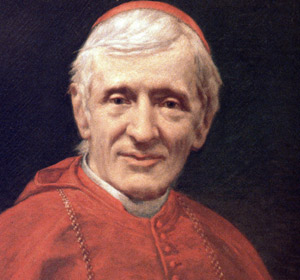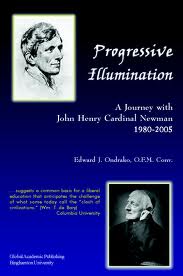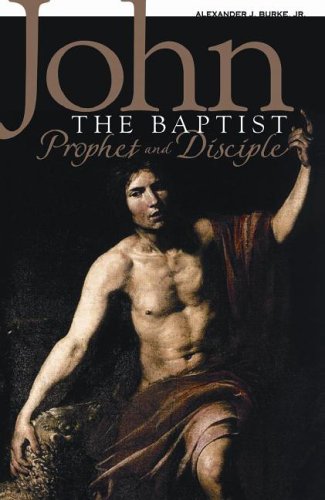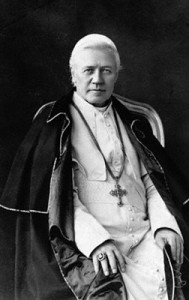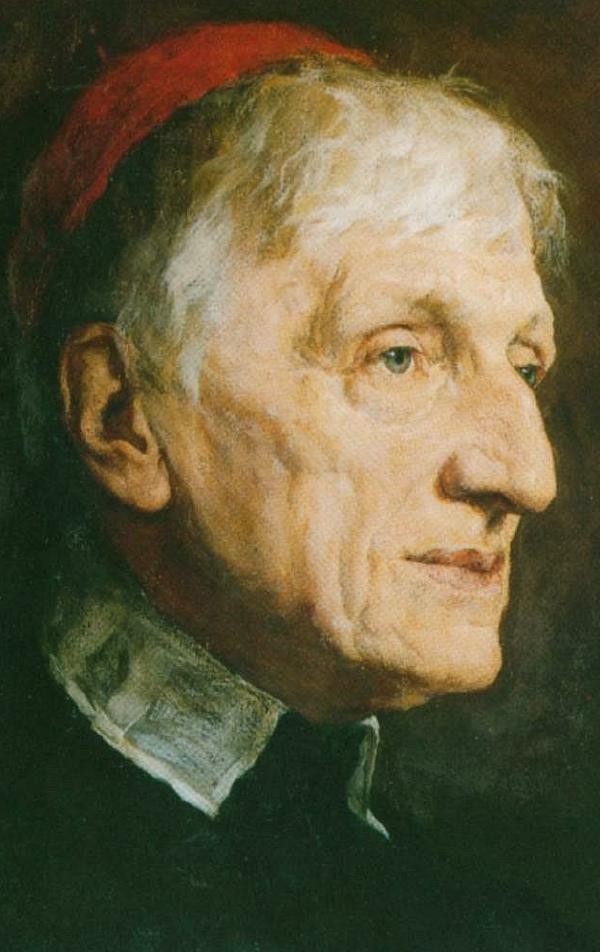 “Much loved father of souls…” Pope Benedict XVI
“Much loved father of souls…” Pope Benedict XVI
As reported by the Catholic Herald UK
Pope Benedict XVI today beatified Cardinal John Henry Newman in a historic Mass at Cofton Park, Birmingham – the first beatification ever to take place on British soil.
In his homily, the Pope placed Cardinal Newman in a tradition of English martyrs and saintly scholars, and praised the “warmth and humanity†of his priestly ministry.
He also noted that it was the 70th anniversary of the Battle of Britain, and paid tribute to English men and women who resisted the “evil ideology†of Nazism.
He said: “For me as one who lived and suffered through the dark days of the Nazi regime in Germany, it is deeply moving to be here with you on this occasion, and to recall how many of your fellow citizens sacrificed their lives, courageously resisting the forces of that evil ideology.
“My thoughts go in particular to nearby Coventry, which suffered such heavy bombardment and massive loss of life in November 1940,†the Pope said.
He explained Newman was the latest in a “long line†of saintly British scholars, including St Bede, St Hilda, St Aelred, and Blessed Duns Scotus. It was a tradition, he said, “of gentle scholarship, deep human wisdom and profound love for the Lordâ€.
He pointed to Newman’s “devoted care for the people of Birmingham … visiting the sick and the poor, comforting the bereaved, caring for those in prisonâ€.
“No wonder,†he said, “that on his death so many thousands of people lined the local streets as his body was taken to its place of burial not half a mile from hereâ€.
The Pope said that given his holiness it was fitting he should take his place beside England’s martyrs, “whose courageous witness has sustained and inspired the Catholic community here for centuriesâ€.
Pope Benedict said his vision of education had “done so much to shape the ethos that is the driving force behind Catholic schools and colleges todayâ€.
He quoted Cardinal Newman’s appeal for a well-instructed laity as a goal for all teachers of religion. He said: “ ‘I want a laity not arrogant, not rash in speech, not disputatious, but men who know their religion, who enter into it, who know just where they stand, who know what they hold and what they do not, who know their creed so well that they can give an account of it, who know so much of history that they can defend it.’ â€
The Pope added: “I pray that, through his intercession and example, all who are engaged in the task of teaching and catechesis will be inspired to greater effort by the vision he so clearly sets before us.â€
He also spoke about Newman’s holiness, saying it was a “profound desire of the human heart to enter into intimate communion with the Heart of Godâ€.
The Pope spoke in front of tens of thousands of pilgrims, some of whom had slept overnight at Cofton Park in sleeping bags. Others had set off from parishes as early as 2am in special pilgrim buses. Fr Tim Finigan, parish priest at Blackfen, Kent, tweeted: “Apologies to the neighbours for waking them up last night singing ‘God bless our Pope’ as the coach left for Birmingham. Won’t happen again.â€
According to Simon Caldwell, the Catholic Herald’s news editor, rain poured down all morning until just before the Pope’s helicopter landed nearby, when the sun finally came out.
Deacon Jack Sullivan, who was healed of a severe spinal disorder after praying for Newman’s intercession, proclaimed the Gospel during the Mass. It was his inexplicable healing that led to Newman being made a Blessed.
A choir of 1,200 sung a new setting of the Mass by composer James MacMillan. The prayers of the faithful were made in German, Welsh, French, Vietnamese and Punjabi.” – Catholic Herald UK
Tags: catholic, catholic podcast, catholic prayer, cathollc spirituality, john henry newman, pope benedict xvi
This entry was posted on Sunday, September 19th, 2010 at 9:32 pm
You can follow any responses to this entry through the RSS 2.0 feed.
The truth had more value than security and prestige. He stressed a life of virtue. His life would emphasize that both the habits of knowledge, along with  the habits of  virtue, lead to the birth of the habit of right judgement in our lives. Boy now there is the key isn’t it. We can have knowledge…we can have virtue…but are the two truly united, “married” so to speak, to bring about in our hearts and our minds, right judgement. Look around the world today, is there the practice of  “right judgement’? Sound complicated? Not really, it’s at the heart of true and proper discernment. And that’s why Blessed John Henry Newman is a vital saint for today’s world.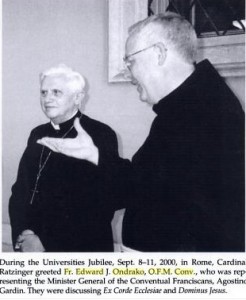
One of the best books I’ve ever read on the teachings of Blessed John Henry Cardinal Newman was “Progressive Illumination”. And one my favorite discussions on his life was with Fr. Edward Ondrako OFM Conv. What’s great about Fr. Ondrako is that not only thinks “Newman”, he prays “Newman. And he shows us how it brings us all to the heart of Christ.
Take a listen to the conversation Bruce and I had with Fr. Ondrako on the Spirit Morning Show
Â
Â
A wonderful book on Blessed John Henry Newman is “Progressive Illumination” by Fr. Ondrako
Tags: catholic, catholic podcast, catholic prayer, cathollc spirituality, conscience, discernment, john henry cardinal newman, john henry newman
This entry was posted on Sunday, September 19th, 2010 at 7:57 am
You can follow any responses to this entry through the RSS 2.0 feed.
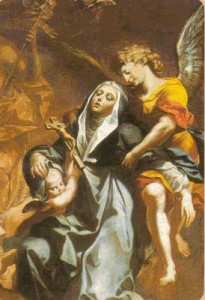 There’s somethng that happens when you not only read and recite but when you also hear…when you listen deeply and profoundly. The private revelation which was given to St. Bridget of Sweden that day in the chapel of the church of St. Paul’s Outside the Walls in Rome over 600 years ago is still one of the most poignant and compelling moments in all mystical experiences. The Church has deemed this worthy of belief to the extent that it can edify one’s faith rather than hurt; that indeed if practiced and nurtured it could open the heart for an outpouring of grace.
There’s somethng that happens when you not only read and recite but when you also hear…when you listen deeply and profoundly. The private revelation which was given to St. Bridget of Sweden that day in the chapel of the church of St. Paul’s Outside the Walls in Rome over 600 years ago is still one of the most poignant and compelling moments in all mystical experiences. The Church has deemed this worthy of belief to the extent that it can edify one’s faith rather than hurt; that indeed if practiced and nurtured it could open the heart for an outpouring of grace.
The “Pieta Prayers” of St. Bridget of Sweden can be a challenging practice in today’s world. To help foster a greater understanding and devotion to Our Lord’s Passion, Discerning Hearts has produced a MP3 Downloadable audio which we hope will assist you in some way.
[powerpress = “Devotionals-Prayers”]Â (featuring Bruce McGregor and Denise Wharton)
For the complete texts, promises and ecclesial advisements click here
Tags: 15 prayers of st bridget, catholic, catholic podcast, catholic prayer, cathollc spirituality, devotion, Discerning Hearts, hope, mp3 downloadable, mystic, mystic of the Church, mystical experiences, pieta, prayers, private revelation, st bridget of sweden, Sweden, women of the middle ages
This entry was posted on Saturday, September 18th, 2010 at 5:12 pm
You can follow any responses to this entry through the RSS 2.0 feed.
Who is he? Why should you care? 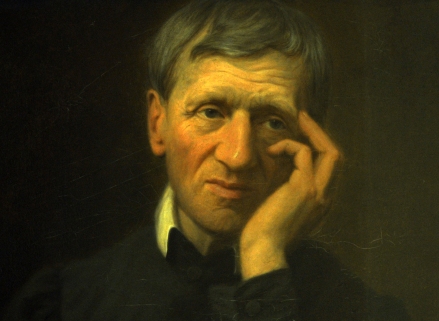
(that almost looks like what he is thinking, doesn’t it?)….Well besides the fact that he is one of newest members sitting in the “Saint” section of the Cloud of Witnesses, he’s British and for those of us who are of English ancestory it’s kind of nice to have a British saint who didn’t have to be martyred at the hands of fellow countrymen to get there!
Brilliant…that’s the word…simply brilliant…that’s Cardinal John Henry Newman. We’ll have more about him in later posts. But an excellent way to start to learn more about him would be to  check out Dr. R. R. Reno, professor of Theology 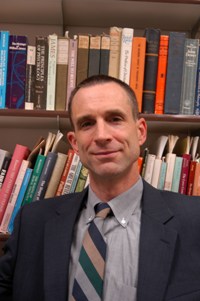 at Creighton University discussing Newman’s life and times, and the significance of his work on his “Christian Apologetics” show.
at Creighton University discussing Newman’s life and times, and the significance of his work on his “Christian Apologetics” show.
Tags: cardinal john henry, catholic, catholic podcast, catholic prayer, cathollc spirituality, christian apologetics, creighton university, john henry newman, r r reno, theology
This entry was posted on Thursday, September 16th, 2010 at 3:24 pm
You can follow any responses to this entry through the RSS 2.0 feed.
Episode 2 – The Mass: the Universal Sign
Roots of the Faith – From the Church Fathers to You with Mike Aquilina,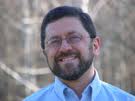 makes clear that just as an acorn grows into a tree and yet remains the same plant, so the Catholic Church is a living organism that has grown from the faith of the earliest Christians into the body of Christ we know today. Hosted by Kris McGregor
makes clear that just as an acorn grows into a tree and yet remains the same plant, so the Catholic Church is a living organism that has grown from the faith of the earliest Christians into the body of Christ we know today. Hosted by Kris McGregor
[powerpress]
Also visit Mike’s “Discerning Hearts†page for more audio downloads and information!
Tags: catholic, catholic podcast, catholic prayer, cathollc spirituality, church fathers, early church, eucharist, eucharistic liturgy, mike aquilina, servant books, the mass, the Universal Sign Roots
This entry was posted on Wednesday, September 15th, 2010 at 2:50 pm
You can follow any responses to this entry through the RSS 2.0 feed.
Dr. Patricia Cooney Hathaway concentrates on helping women understand the relationship between 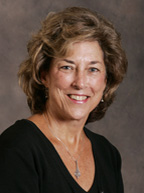 faith and human experience during the middle years within the context of the whole life cycle. This book is EXCELLENT! She explores the wrenching and puzzling questions women in their middle years need to ask: Who am I? Who am I with? Where am I going in terms of a life plan? What aids or blocks my growth? Is God a personal God who is invested in my life? Do I have a personal destiny related to God? What is the meaning of suffering? What is my fate after death?  Drawing from the Mystical Doctors of the Church, Dr. Hathaway offeres an ou
faith and human experience during the middle years within the context of the whole life cycle. This book is EXCELLENT! She explores the wrenching and puzzling questions women in their middle years need to ask: Who am I? Who am I with? Where am I going in terms of a life plan? What aids or blocks my growth? Is God a personal God who is invested in my life? Do I have a personal destiny related to God? What is the meaning of suffering? What is my fate after death?  Drawing from the Mystical Doctors of the Church, Dr. Hathaway offeres an ou tstanding spiritual resource for women.
tstanding spiritual resource for women.
[powerpress]
Click here to pick up a copy of Patricia’s book
Tags: catholic, catholic podcast, catholic prayer, cathollc spirituality, Cooney Hathaway, human experience, Patricia Cooney Hathaway, women
This entry was posted on Tuesday, September 14th, 2010 at 8:56 pm
You can follow any responses to this entry through the RSS 2.0 feed.
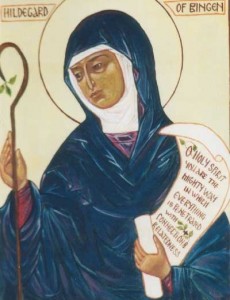 Once again the Holy Father, Pope Benedict XVI speaks of the importance of St. Hildegard of Bingen.
Once again the Holy Father, Pope Benedict XVI speaks of the importance of St. Hildegard of Bingen.
Vatican City – Pope Benedict’s General Audience from Vatican.va
Dear Brothers and Sisters, Today I would like to take up and continue my Reflection on St Hildegard of Bingen, an important female figure of the Middle Ages who was distinguished for her spiritual wisdom and the holiness of her life. Hildegard’s mystical visions resemble those of the Old Testament prophets: expressing herself in the cultural and religious categories of her time, she interpreted the Sacred Scriptures in the light of God, applying them to the various circumstances of life. Thus all those who heard her felt the need to live a consistent and committed Christian lifestyle. In a letter to St Bernard the mystic from the Rhineland confesses: “The vision fascinates my whole being: I do not see with the eyes of the body but it appears to me in the spirit of the mysteries…. I recognize the deep meaning of what is expounded on in the Psalter, in the Gospels and in other books, which have been shown to me in the vision. This vision burns like a flame in my breast and in my soul and teaches me to understand the text profoundly” (Epistolarium pars prima I-XC: CCCM 91). Hildegard’s mystical visions have a rich theological content. They refer to the principal events of salvation history, and use a language for the most part poetic and symbolic. For example, in her best known work entitled Scivias, that is, “You know the ways” she sums up in 35 visions the events of the history of salvation from the creation of the world to the end of time. With the characteristic traits of feminine sensitivity, Hildegard develops at the very heart of her work the theme of the mysterious marriage between God and humanity that is brought about in the Incarnation. On the tree of the Cross take place the nuptials of the Son of God with the Church, his Bride, filled with grace and the ability to give new children to God, in the love of the Holy Spirit (cf. Visio tertia: PL 197, 453c).
From these brief references we already see that theology too can receive a special contribution from women because they are able to talk about God and the mysteries of faith using their own particular intelligence and sensitivity. I therefore encourage all those who carry out this service to do it with a profound ecclesial spirit, nourishing their own reflection with prayer and looking to the great riches, not yet fully explored, of the medieval mystic tradition, especially that represented by luminous models such as Hildegard of Bingen.
The Rhenish mystic is also the author of other writings, two of which are particularly important since, like Scivias, they record her mystical visions: they are the Liber vitae meritorum (Book of the merits of life) and the Liber divinorum operum (Book of the divine works), also called De operatione Dei. In the former she describes a unique and powerful vision of God who gives life to the cosmos with his power and his light. Hildegard stresses the deep relationship that exists between man and God and reminds us that the whole creation, of which man is the summit, receives life from the Trinity. The work is centred on the relationship between virtue and vice, which is why human beings must face the daily challenge of vice that distances them on their way towards God and of virtue that benefits them. The invitation is to distance themselves from evil in order to glorify God and, after a virtuous existence, enter the life that consists “wholly of joy”. In her second work that many consider her masterpiece she once again describes creation in its relationship with God and the centrality of the human being, expressing a strong Christo-centrism with a biblical-Patristic flavour. The Saint, who presents five visions inspired by the Prologue of the Gospel according to St John, cites the words of the Son to the Father: “The whole task that you wanted and entrusted to me I have carried out successfully, and so here I am in you and you in me and we are one” (Pars III, Visio X: PL 197, 1025a). Finally, in other writings Hildegard manifests the versatility of interests and cultural vivacity of the female monasteries of the Middle Ages, in a manner contrary to the prejudices which still weighed on that period. Hildegard took an interest in medicine and in the natural sciences as well as in music, since she was endowed with artistic talent. Thus she composed hymns, antiphons and songs, gathered under the title: Symphonia Harmoniae Caelestium Revelationum (Symphony of the Harmony of Heavenly Revelations), that were performed joyously in her monasteries, spreading an atmosphere of tranquillity and that have also come down to us. For her, the entire creation is a symphony of the Holy Spirit who is in himself joy and jubilation.
The popularity that surrounded Hildegard impelled many people to seek her advice. It is for this reason that we have so many of her letters at our disposal. Many male and female monastic communities turned to her, as well as Bishops and Abbots. And many of her answers still apply for us. For instance, Hildegard wrote these words to a community of women religious: “The spiritual life must be tended with great dedication. At first the effort is burdensome because it demands the renunciation of caprices of the pleasures of the flesh and of other such things. But if she lets herself be enthralled by holiness a holy soul will find even contempt for the world sweet and lovable. All that is needed is to take care that the soul does not shrivel” (E. Gronau, Hildegard. Vita di una donna profetica alle origini dell’età moderna, Milan 1996, p. 402). And when the Emperor Frederic Barbarossa caused a schism in the Church by supporting at least three anti-popes against Alexander iii, the legitimate Pope, Hildegard did not hesitate, inspired by her visions, to remind him that even he, the Emperor, was subject to God’s judgement. With fearlessness, a feature of every prophet, she wrote to the Emperor these words as spoken by God: “You will be sorry for this wicked conduct of the godless who despise me! Listen, O King, if you wish to live! Otherwise my sword will pierce you!” (ibid., p. 412). With the spiritual authority with which she was endowed, in the last years of her life Hildegard set out on journeys, despite her advanced age and the uncomfortable conditions of travel, in order to speak to the people of God. They all listened willingly, even when she spoke severely: they considered her a messenger sent by God. She called above all the monastic communities and the clergy to a life in conformity with their vocation. In a special way Hildegard countered the movement of German cátari (Cathars). They cátari means literally “pure” advocated a radical reform of the Church, especially to combat the abuses of the clergy.
She harshly reprimanded them for seeking to subvert the very nature of the Church, reminding them that a true renewal of the ecclesial community is obtained with a sincere spirit of repentance and a demanding process of conversion, rather than with a change of structures. This is a message that we should never forget. Let us always invoke the Holy Spirit, so that he may inspire in the Church holy and courageous women, like St Hildegard of Bingen, who, developing the gifts they have received from God, make their own special and valuable contribution to the spiritual development of our communities and of the Church in our time.
Tags: catholic, catholic podcast, catholic prayer, cathollc spirituality, Church, courageous women, Hildegard of Bingen, holy spirit, mysteries, mystic of the Church, mystics, pope benedict, pope benedict xvi, st hildegard of bingen, women, women of the middle ages
This entry was posted on Wednesday, September 8th, 2010 at 4:08 pm
You can follow any responses to this entry through the RSS 2.0 feed.
Episode 1 – Witnesses to Tradition. A grand overview of Church tradition as passed down to us by the Fathers of the Church…it’s scope and relevance for our lives today!
[powerpress]
Roots of the Faith – From the Church Fathers to You with Mike Aquilina, makes clear that just as an acorn grows into a tree and yet remains the same plant, so the Catholic Church is a living organism that has grown from the faith of the earliest Christians into the body of Christ we know today. Hosted by Kris McGregor
makes clear that just as an acorn grows into a tree and yet remains the same plant, so the Catholic Church is a living organism that has grown from the faith of the earliest Christians into the body of Christ we know today. Hosted by Kris McGregor
Also visit Mike’s “Discerning Hearts” page for more audio downloads and information!
Tags: catholic, catholic podcast, catholic prayer, cathollc spirituality, church fathers, church tradition, fathers of the church, mike aquilina, roots of the faith, servant books, the Catholic Church
This entry was posted on Sunday, September 5th, 2010 at 9:41 am
You can follow any responses to this entry through the RSS 2.0 feed.
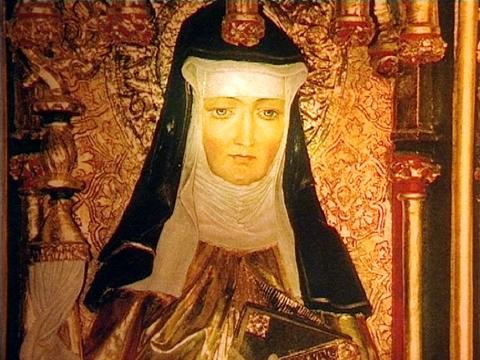 St. Hildegard was a woman who was a great mystic, writer, poet, musician, artist and a devout Benedictine nun!   She valued the hierachy and authority of the Church, and even sought counsel and received validation from the great mystical doctor of the Church, St. Bernard of Clairvaux.Â
St. Hildegard was a woman who was a great mystic, writer, poet, musician, artist and a devout Benedictine nun!   She valued the hierachy and authority of the Church, and even sought counsel and received validation from the great mystical doctor of the Church, St. Bernard of Clairvaux.Â
Papal Summer Residence, Castel Gandolfo
Wednesday, 1st September 2010“Saint Hildegard of Bingen
Dear Brothers and Sisters,
In 1988, on the occasion of the Marian Year, Venerable John Paul II wrote an Apostolic Letter entitled Mulieris Dignitatem on the precious role that women have played and play in the life of the Church. “The Church”, one reads in it, “gives thanks for all the manifestations of the feminine “genius’ which have appeared in the course of history, in the midst of all peoples and nations; she gives thanks for all the charisms that the Holy Spirit distributes to women in the history of the People of God, for all the victories which she owes to their faith, hope and charity: she gives thanks for all the fruits of feminine holiness” (n. 31).
Various female figures stand out for the holiness of their lives and the wealth of their teaching even in those centuries of history that we usually call the Middle Ages. Today I would like to begin to present one of them to you: St Hildegard of Bingen, who lived in Germany in the 12th century. She was born in 1098, probably at Bermersheim, Rhineland, not far from Alzey, and died in 1179 at the age of 81, in spite of having always been in poor health. Hildegard belonged to a large noble family and her parents dedicated her to God from birth for his service. At the age of eight she was offered for the religious state (in accordance with the Rule of St Benedict, chapter 59), and, to ensure that she received an appropriate human and Christian formation, she was entrusted to the care of the consecrated widow Uda of Gölklheim and then to Jutta of Spanheim who had taken the veil at the Benedictine Monastery of St Disibodenberg. A small cloistered women’s monastery was developing there that followed the Rule of St Benedict. Hildegard was clothed by Bishop Otto of Bamberg and in 1136, upon the death of Mother Jutta who had become the community magistra (Prioress), the sisters chose Hildegard to succeed her. She fulfilled this office making the most of her gifts as a woman of culture and of lofty spirituality, capable of dealing competently with the organizational aspects of cloistered life. A few years later, partly because of the increasing number of young women who were knocking at the monastery door, Hildegard broke away from the dominating male monastery of St Disibodenburg with her community, taking it to Bingen, calling it after St Rupert and here she spent the rest of her days. Her manner of exercising the ministry of authority is an example for every religious community: she inspired holy emulation in the practice of good to such an extent that, as time was to tell, both the mother and her daughters competed in mutual esteem and in serving each other.
During the years when she was superior of the Monastery of St Disibodenberg, Hildegard began to dictate the mystical visions that she had been receiving for some time to the monk Volmar, her spiritual director, and to Richardis di Strade, her secretary, a sister of whom she was very fond. As always happens in the life of true mystics, Hildegard too wanted to put herself under the authority of wise people to discern the origin of her visions, fearing that they were the product of illusions and did not come from God. She thus turned to a person who was most highly esteemed in the Church in those times: St Bernard of Clairvaux, of whom I have already spoken in several Catecheses. He calmed and encouraged Hildegard. However, in 1147 she received a further, very important approval. Pope Eugene iii, who was presiding at a Synod in Trier, read a text dictated by Hildegard presented to him by Archbishop Henry of Mainz. The Pope authorized the mystic to write down her visions and to speak in public. From that moment Hildegard’s spiritual prestige continued to grow so that her contemporaries called her the “Teutonic prophetess”.
This, dear friends, is the seal of an authentic experience of the Holy Spirit, the source of every charism: the person endowed with supernatural gifts never boasts of them, never flaunts them and, above all, shows complete obedience to the ecclesial authority. Every gift bestowed by the Holy Spirit, is in fact intended for the edification of the Church and the Church, through her Pastors, recognizes its authenticity.
I shall speak again next Wednesday about this great woman, this “prophetess” who also speaks with great timeliness to us today, with her courageous ability to discern the signs of the times, her love for creation, her medicine, her poetry, her music, which today has been reconstructed, her love for Christ and for his Church which was suffering in that period too, wounded also in that time by the sins of both priests and lay people, and far better loved as the Body of Christ. Thus St Hildegard speaks to us; we shall speak of her again next Wednesday. Thank you for your attention.”
God is the foundation for everything
This God undertakes, God gives.
Such that nothing that is necessary for life is lacking.
Now humankind needs a body that at all times honors and praises God.
This body is supported in every way through the earth.
Thus the earth glorifies the power of God.
Visit the Discerning Hearts
St. Hildegard von Bingen page
for more on this Doctor of the Church
Tags: Anglican Episcopal, catholic, catholic podcast, catholic prayer, cathollc spirituality, Church, holy father, Matthew Fox, mystic, mystic of the Church, mystical visions, New Agers, st bernard of clairvaux, st hildegard of bingen, st. hildegarde, Vatican Information Service, women of the middle ages
This entry was posted on Thursday, September 2nd, 2010 at 3:14 pm
You can follow any responses to this entry through the RSS 2.0 feed.
.
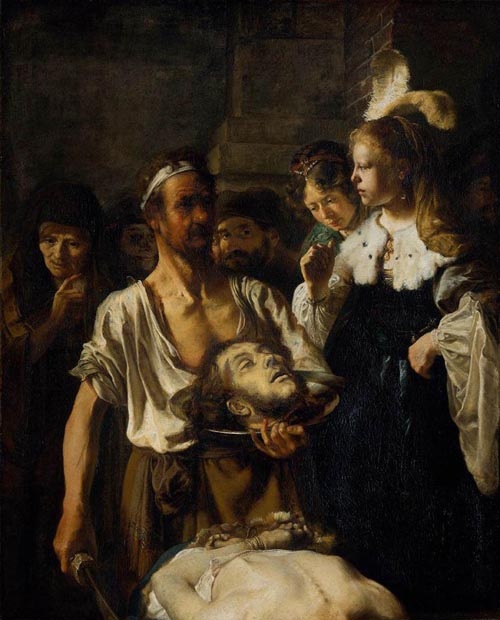 The Martyrdom of John the Baptist is a nasty one. To behead a man in payment for a dance? It kind of makes you sick to your stomach, doesn’t it? The heads of the seven deadly (cardinal) sins really show themselves in this incident: pride (Herod, Herodias), envy (Herodias), anger (Herodias), lust (Herod’s for his dancing step-daughter, Salome), gluttony (Herod, the party goers, Herodias), sloth (Herod), greed (Herodias). And yet, it is part of one of the greatest stories of the triumph of humility every told.Â
The Martyrdom of John the Baptist is a nasty one. To behead a man in payment for a dance? It kind of makes you sick to your stomach, doesn’t it? The heads of the seven deadly (cardinal) sins really show themselves in this incident: pride (Herod, Herodias), envy (Herodias), anger (Herodias), lust (Herod’s for his dancing step-daughter, Salome), gluttony (Herod, the party goers, Herodias), sloth (Herod), greed (Herodias). And yet, it is part of one of the greatest stories of the triumph of humility every told. .
Tags: alexander j burke, beheading of st john the baptist, cardinal sins, catholic, catholic podcast, catholic prayer, cathollc spirituality, martyrdom, st john the baptist
This entry was posted on Sunday, August 29th, 2010 at 9:40 am
You can follow any responses to this entry through the RSS 2.0 feed.
Agnes Gonxha Bojaxhiu – (pronounced [aɡˈnÉ›s ˈɡɔndÊ’e bÉ”jaˈdÊ’iu]  uuuhhh, I don’t think that helps?), (Gonxhe mea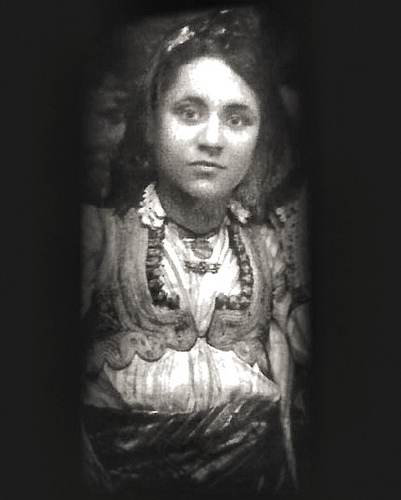 ning “rosebud” in Albanian) was born August 26, 1910. Â
ning “rosebud” in Albanian) was born August 26, 1910. Â
She was the youngest of the children of a family from Shkodër, Albania, born to Nikollë and Drana Bojaxhiu.  Her father, who was involved in Albanian politics, died in 1919 when she was eight years old. After her father’s death, her mother raised her as a Roman Catholic. Her father’s origin was possibly from Prizren, Kosovo while her mother’s origin was possibly from a village near Gjakova, Kosovo.
According to a biography by Joan Graff Clucas, in her early years Agnes was fascinated by stories of the lives of missionaries and their service, and by age 12 was convinced that she should commit herself to a religious life.  She left home at age 18 to join the Sisters of Loreto as a missionary. She never again saw her mother or sister. – Wikipedia
as a missionary. She never again saw her mother or sister. – Wikipedia
And so begins the 100 year celebration of the life of one the 20th centuries greatest saints, Mother Teresa.  We will have more on her teachings and her life over the coming days and months.Â
 Check out the movie I just love on her life, “Mother Teresa” starring the wonderful Olivia Hussy. Bruce and I had a chance to talk with Olivia…what a blessing. Bruce, kind of, sort of, had a crush on her since he was a teenage boy (Romeo and Juliet days for Olivia) and I, of course, loved her as Mary in “Jesus of Nazareth”. We both thought she
Check out the movie I just love on her life, “Mother Teresa” starring the wonderful Olivia Hussy. Bruce and I had a chance to talk with Olivia…what a blessing. Bruce, kind of, sort of, had a crush on her since he was a teenage boy (Romeo and Juliet days for Olivia) and I, of course, loved her as Mary in “Jesus of Nazareth”. We both thought she was fantastic in this film, and a delight to speak with. Olivia had much to share about Mother Teresa and the making of the film…it’s one of our favorite interviews!
was fantastic in this film, and a delight to speak with. Olivia had much to share about Mother Teresa and the making of the film…it’s one of our favorite interviews!
 You can find it on Amazon.com
Â
Tags: 100th birthday, catholic, catholic podcast, catholic prayer, cathollc spirituality, celebration, mother teresa, olivia hussy, religious life, sisters of loreto
This entry was posted on Thursday, August 26th, 2010 at 12:24 am
You can follow any responses to this entry through the RSS 2.0 feed.
Tags: catholic, catholic podcast, catholic prayer, cathollc spirituality, our lady of czetochowa
This entry was posted on Thursday, August 26th, 2010 at 12:01 am
You can follow any responses to this entry through the RSS 2.0 feed.
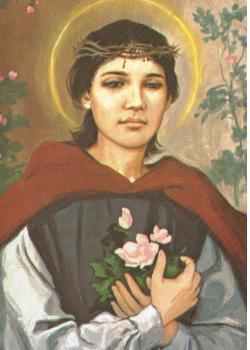 St. Rose of Lima, is the 1st person canonized a saint in the Americas and is considered the patron of Latin America and the Philippines.
St. Rose of Lima, is the 1st person canonized a saint in the Americas and is considered the patron of Latin America and the Philippines.
Her story is really as lovely as her name. Born Isabel (which in itself means Beauty) in 1586, she was so beautiful that they simply called her Rose.  She felt a special relationship with Jesus in her heart at very young age; and felt a close tie to St. Catherine of Siena.  Undoubtedly a she experienced deep mystical experiences in prayer. Like many who have those types of graces, she felt called to extraordinary acts of penance not only for herself but for all mankind. It is said that she would place a pepper/lye-based oil on her skin in order to marr her complexi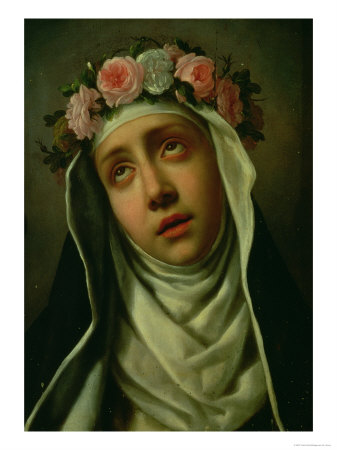 on so as not to be a source of temptation for others and to eliminate the potential for vanity in herself. Ok, so that may seem extreme today, but don’t forget it was an act not unlike that of St. Clare, who cut her hair in order to become unmarriageable…St. Rose’s motivation may have shared some of that intention. She had a great devotion to and relationship with the child Jesus; you will see him with her in many of the paintings depicting her life. She died in 1617 and was canonized 1671.
on so as not to be a source of temptation for others and to eliminate the potential for vanity in herself. Ok, so that may seem extreme today, but don’t forget it was an act not unlike that of St. Clare, who cut her hair in order to become unmarriageable…St. Rose’s motivation may have shared some of that intention. She had a great devotion to and relationship with the child Jesus; you will see him with her in many of the paintings depicting her life. She died in 1617 and was canonized 1671.
The video is a wonderful one; the images tell the story. For those of you who do not speak Spanish don’t sweat it…remember it was her native language (her father was Spanish, her mother part Spanish and Inca), and well…well allow yourself to stretch a little, it’s so worth viewing, if only to get to know St. Rose and her people better.
Tags: catholic, catholic podcast, catholic prayer, cathollc spirituality, latin america, mystical experiences, patron, st catherine of siena, st rose of lima, true beauty
This entry was posted on Monday, August 23rd, 2010 at 7:18 pm
You can follow any responses to this entry through the RSS 2.0 feed.
The Pope of the Blessed Sacrament
“Itching Ears Among Us
Saint Pius X exemplified the words of the Apostle to Timothy: “Preach the word, be urgent in season and out of season, convince, rebuke, and exhort, be unfailing in patience and in teaching. For the time is coming when people will not endure sound teaching, but having itching ears they will accumulate for themselves teachers to suit their own likings, and will turn away from listening to the truth and wander into myths†(2 Tim 4:2–4). One hundred years after Pope Saint Pius X we have to ask ourselves if there are not still “itching ears†among us.
What causes one’s ears to itch? Curiosity. Lack of discernment. A weak background in Catholic doctrine. Faithful Catholics cannot permit themselves to read just anything. To read authors of dubious orthodoxy or authors critical of the Magisterium is like scratching an itch. It becomes worse. Why would one would even want to read such authors when one can choose from among the inexhaustible richness of the writings of the saints of every age?
It was Saint Pius X who opened Holy Communion to little children. He invited the Catholic faithful to frequent, even daily Holy Communion. Pius X came to be known as the “Pope of the Eucharist,†a title that he now shares with Pope John Paul II, the author of Ecclesia de Eucharistia and of Mane Nobiscum, Domine.” – for more go to Vultus Christi
I see that serious face of the young boy to the right, and I wonder what he is thinking. His family was so poor. Giuseppe Melchiorre Sarto was born in 1835, the second of ten children. His father was the village postman. Though poor, his parents valued education and made every effort in securing that gift for their children.
Pope Pius was a Marian Pope, whose encyclical Ad Diem Illum expresses his desire through Mary to renew all things in Christ, which he had defined as his motto in his first encyclical. Pius believed that there is no surer or more direct road than by Mary to achieve this goal (no wonder he had such a beautiful heart). Pius X was the only Pope in the 20th century with extensive pastoral experience at the parish level, and pastoral concerns permeated his papacy; he favoured the use of the vernacular in catechesis. Frequent communion was a lasting innovation of his papacy. He spoke plainly and with strength, and because of that he was not well like by the elite and the rich.  He often referred to his own humble origins, taking up the causes of poor people. I was born poor, I have lived poor, and I wish to die poor
This is a wonderful prayer by the saint himself:
O Lord Jesus Christ, let Your passion be my strength to sustain, guard, and protect me. Let Your wounds be my food and drink to nourish, fill, and invigorate me. Let the shedding of Your Blood cleanse me of all my sins. Let Your death obtain eternal life for me and Your cross lead me to everlasting glory. Let these constitute for me refreshment and joy, health and uprightness of heart.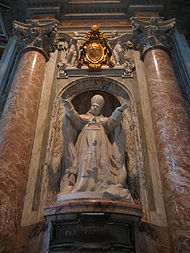 Â Â Amen.
  Amen.
Tags: Ad Diem Illum, catholic, catholic doctrine, catholic podcast, catholic prayer, cathollc spirituality, children, eternal life, holy communion, pope saint pius x
This entry was posted on Saturday, August 21st, 2010 at 7:03 am
You can follow any responses to this entry through the RSS 2.0 feed.
Content very good…music a little much, but it gives us a chance to offer it up…or turn it down
Tags: catholic, catholic podcast, catholic prayer, cathollc spirituality, music
This entry was posted on Monday, August 16th, 2010 at 7:12 pm
You can follow any responses to this entry through the RSS 2.0 feed.

